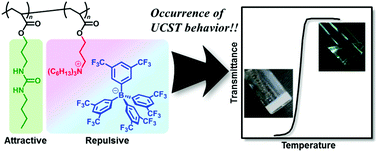Thermoresponsivity of polymer solution derived from a self-attractive urea unit and a self-repulsive lipophilic ion unit†
Abstract
The preparation of the polymers having a self-attractive urea unit via hydrogen bonding and a self-repulsive lipophilic ion unit via electrostatic interaction was carried out to achieve the thermoresponsivity of polymer solution. The solubility of the obtained copolymers depended on the balance between the attractive force induced by hydrogen bonding among the urea units and the repulsive force attributed to the dissociation of the ionic units. In aprotic and nonpolar solvents, the solubility of the polymers was changed from insoluble to soluble with the increasing content of the ionic units. Moreover, in acetonitrile and 1,2-dichloroethane, the UCST-type thermoresponsivity was observed. This result indicated that the UCST-type thermoresponsivity was induced by cleavage of the hydrogen bonds among urea units upon heating, and at the cloud point, the repulsive force among the ionic units overwhelmed the attractive force. From the result of this research, we would like to emphasize that the combination of a lipophilic ion pair and other self-attractive units can be a simple principle for the molecular design of UCST-type thermoresponsive polymers in any media.



 Please wait while we load your content...
Please wait while we load your content...